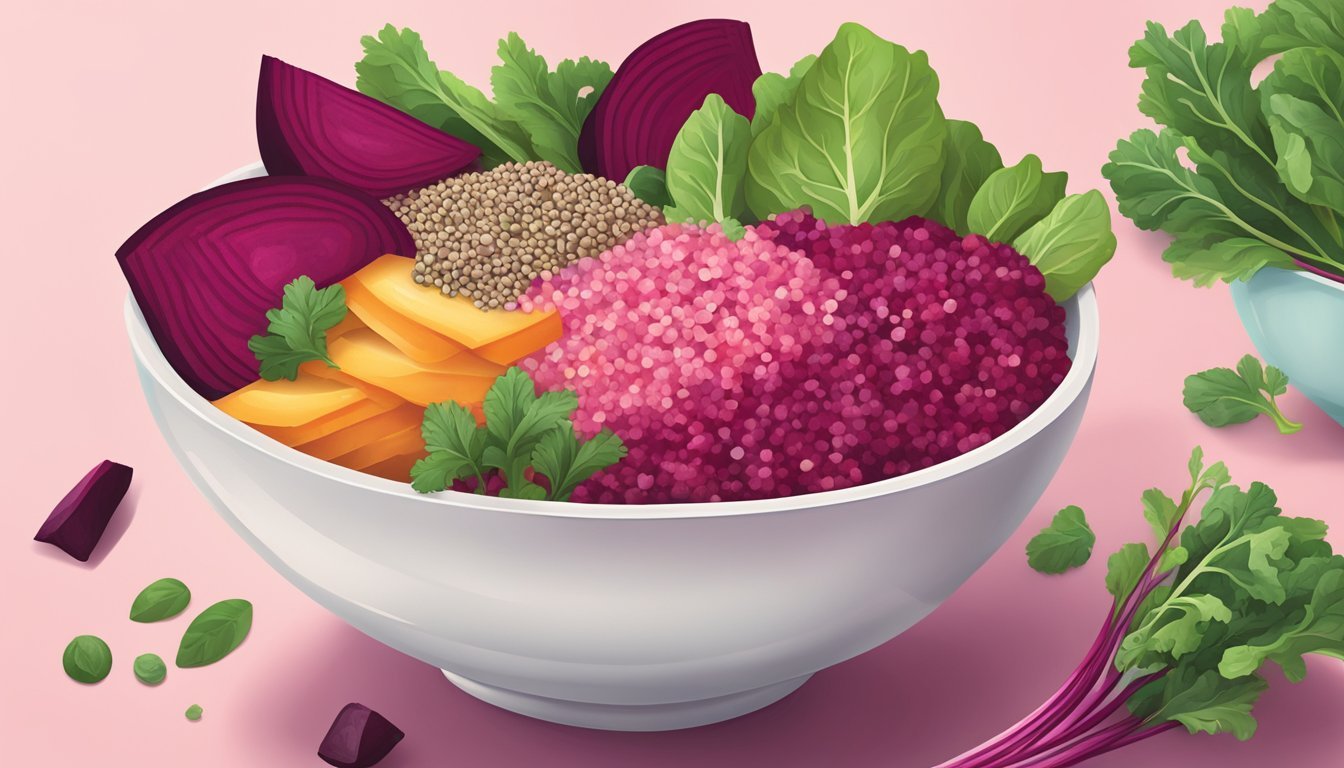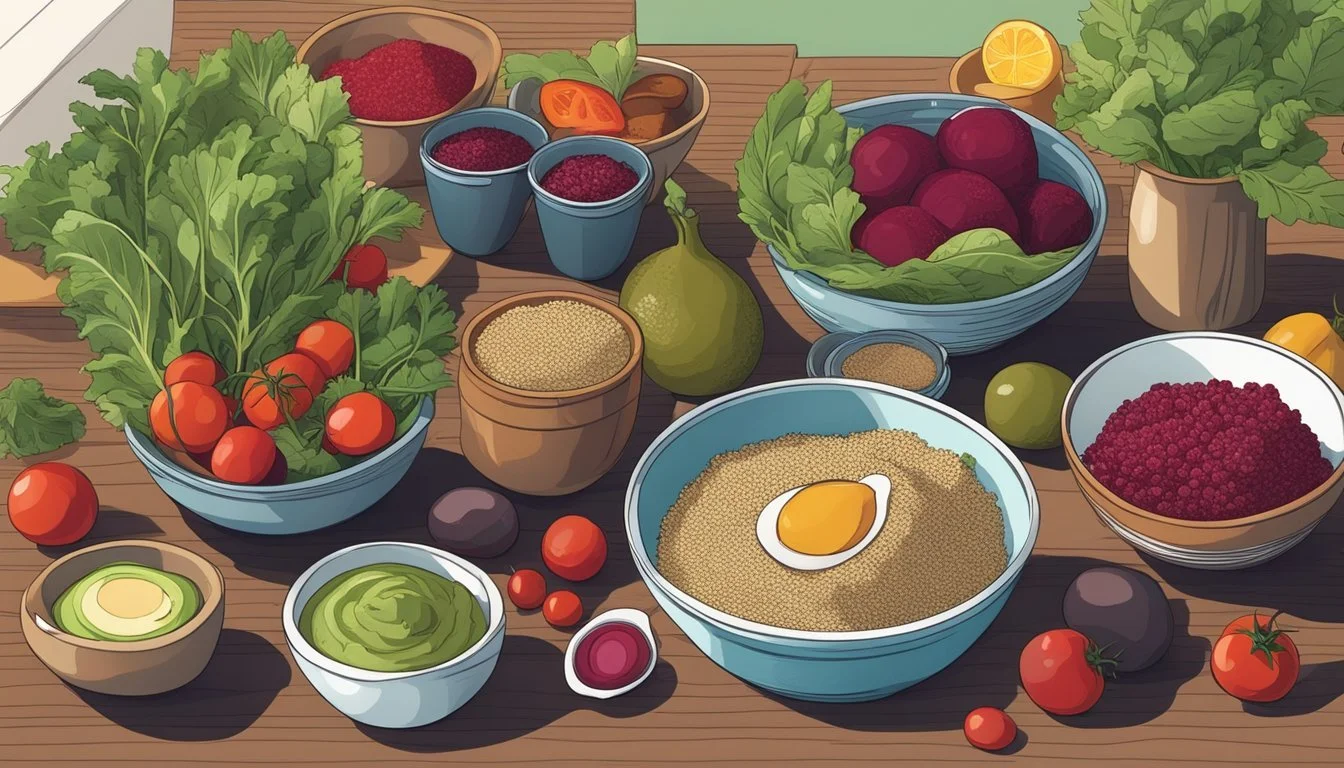Beet Quinoa Bowl
Beet quinoa (What wine goes well with quinoa?) bowls present a vibrant blend of nutrition and flavor, ideal for a healthy meal that doesn't skimp on taste. The earthy flavor of roasted beets (how long do beets last?), combined with the fluffy texture of quinoa, creates a satisfying base for a variety of additional ingredients. Rich in essential nutrients, this dish leverages the deep hues of beets, available in shades from ruby red to golden yellow, to make each bowl a visual feast as well. When prepared with olive oil, a hint of black pepper, and perhaps a tang of balsamic vinegar, these bowls exude an extra layer of flavor complexity.
The preparation of a beet quinoa bowl can begin with drizzling olive oil over peeled and cubed beets placed on a baking sheet, then roasting until tender. Meanwhile, cooking dry quinoa until it's light and fluffy can be as simple as combining the grains with water in a pot over medium heat. To complement the nutrient-rich beet greens, which can be sautéed with a touch of garlic in olive oil, one might add goat cheese or feta for a creamy contrast, or cubed avocado (how long does avocado last?) for a smooth, rich texture.
Including an assortment of greens like arugula (how long does arugula last?) or kale, a splash of citrus with lemon juice or orange zest, or sweetness from honey or raisins transforms this meal into a delightful quinoa salad. Whether served as a main dish or a side, the beet quinoa bowl is as versatile as it is delicious—with leftovers easily stored in an airtight container for a quick and nutritious meal option on busy days.
Ingredients And Substitutions
Preparing a Beet Quinoa Bowl involves combining the hearty texture of cooked quinoa (how long does cooked quinoa last?) with the rich flavor of roasted beets, among other ingredients. This section outlines essential components and potential variations to customize the dish to personal tastes or dietary requirements.
Core Ingredients
Roasted Beets: To roast beets, preheat your oven and wrap whole, peeled beets in foil with a drizzle of olive oil and a pinch of salt. You can substitute golden beets for a milder, sweeter taste without altering the cooking method.
Cooked Quinoa: Start with dry quinoa and rinse under cold water to remove any saponins. Then combine 1 part quinoa to 2 parts water in a pot and cook until the quinoa is fluffy. Avocado oil can replace olive oil when toasting the quinoa for an extra flavor variation.
Olive Oil: Use extra virgin olive oil for dressing and roasting for its quality and flavor. For a different taste, opt for avocado oil or a mild vegetable oil.
Greens: Kale and arugula are common for adding a peppery note to the bowl. Beet greens can also be used for their earthy flavor and to minimize waste.
Acid: Fresh lemon juice and zest can brighten the dish. Balsamic or white wine vinegar are suitable substitutions that complement the earthy beets.
Cheese: Goat cheese is a creamy and tangy option for this bowl. Feta cheese can be an alternative for a stronger brine influence. If avoiding dairy, omit the cheese or use a non-dairy alternative.
Additional Flavorings: Salt, black pepper, and garlic enhance the bowl's flavor profile. Honey, raisins, or a splash of orange juice can be added for natural sweetness.
Toppings and Extras: Cubed avocado adds creaminess, while nuts like almonds add crunch. For a different texture or if nuts are an issue, consider using seeds such as pumpkin or sunflower.
To store leftovers, place the quinoa and beets in separate airtight containers and refrigerate to keep the quinoa fluffy and beets moist. Adjust the ingredient ratios based on the size of the meal and personal preference. Any changes made to the recipe should still honor the balance of a healthy meal that aligns with principles of healthy eating.
Preparation And Cooking Instructions
The key to making a delicious quinoa beet salad lies in cooking each component to bring out their individual flavors before combining them into a satisfying meal.
Cooking Quinoa
To cook fluffy quinoa:
Rinse 1 cup of dry quinoa thoroughly under cold water to remove bitterness.
In a pot, combine the rinsed quinoa with 2 cups of water.
Bring the mixture to a boil over medium heat, then reduce to a simmer.
Cover and cook until the quinoa absorbs the water and is tender, about 15 minutes.
Remove the quinoa from heat, let it sit covered for 5 minutes, then fluff with a fork.
Roasting Beets
For perfectly roasted beets:
Preheat the oven to 400°F (200°C) and line a baking sheet with parchment paper.
Peel and cube 2 medium-sized beets and spread them on the baking sheet.
Drizzle with 2 tablespoons olive oil and season with salt and black pepper.
Roast in the oven until tender and slightly caramelized, about 30-40 minutes.
Assembling the Bowl
Construct your quinoa beet salad bowl:
In a large bowl, combine the fluffy cooked quinoa with the roasted beets.
Add crumbled goat cheese or feta cheese for a creamy contrast to the earthy flavor of the beets.
Introduce fresh elements like kale, arugula, or beet greens, along with sliced avocado for creaminess and toasted nuts or seeds for crunch.
Dress the salad with balsamic or wine vinegar, lemon juice, or a tangy orange dressing, and finish with a sprinkle of salt and pepper.
If meal prepping, store individual components in an airtight container to maintain freshness.
Flavor Pairings, Dressings, and Variations
When crafting a Beet Quinoa Bowl, the right combination of flavors and dressings can elevate the dish from simple to sublime. Fresh, high-quality ingredients are paramount, with items like roasted root vegetables and fluffy quinoa forming the base, ready to be enhanced by an array of seasonings and dressings.
Seasoning Mixes
The key to a flavorful Beet Quinoa Bowl lies in the seasoning. Experiment with different combinations to create a profile that complements the earthy undertones of the beets and the nuttiness of the quinoa.
Basic Blend: A simple mix of salt and cracked black pepper can be used to season both the beets before roasting and the quinoa as it cooks.
Herb Fusion: Incorporate a blend of fresh or dried herbs such as thyme, rosemary, or basil for an aromatic touch.
Cheesy Twist: Crumble goat or feta cheese over the bowl for a creamy texture and a tangy flavor contrast.
Spiced Warmth: For those who enjoy a bit of heat, a pinch of cayenne or flakes of red pepper will add warmth without overpowering.
Homemade Dressings
A homemade dressing can bring together the flavors of the Beet Quinoa Bowl, making each bite a harmonious experience.
Citrus Vinaigrette:
3 tablespoons olive oil or avocado oil
1 tablespoon lemon juice or orange juice
A hint of lemon zest
Salt and pepper to taste Mix the ingredients until well combined and drizzle over the bowl for a zesty, refreshing finish.
Balsamic Bliss:
Remember to dress the Beet Quinoa Bowl just before serving to maintain the vibrant color of the beets and the crisp texture of greens like arugula or kale. Store any leftover dressing in an airtight container and refrigerate to keep it fresh for future meals.
Nutrition And Dietary Considerations
When crafting a Beet Quinoa Bowl, it combines nutrient-dense ingredients like roasted beets, cooked quinoa, and a variety of optional dressings and toppings to provide a meal that is both healthful and adaptable for various diets.
Health Benefits
Roasted Beets: A primary ingredient in beet quinoa bowls, beets are rich in fiber, vitamins, and minerals, and are known for their ability to support heart health due to their nitrate content. The process of roasting not only enhances their sweet, earthy flavor but also retains most of the nutrients.
Cooked Quinoa: Quinoa, a gluten-free grain, serves as an excellent source of protein and all nine essential amino acids, making it a complete protein choice. It's also high in fiber and several key micronutrients, such as magnesium and iron.
Olive Oil: Used for dressing or roasting, olive oil contains monounsaturated fats, which are beneficial for heart health. Choosing extra virgin olive oil can also contribute antioxidants to the meal.
Additional Components: Incorporating elements like kale or arugula adds vitamins A, C, K, and calcium, while toppings such as feta cheese or cubed avocado introduce beneficial fats and provide a creamy texture and rich flavor.
Dietary Substitutions
For individuals with dietary restrictions or preferences, the beet quinoa bowl is highly customizable:
Vegan Options: Replace feta or goat cheese with dairy-free alternatives or nutritional yeast for a cheesy flavor without animal products.
Dressings: A simple dressing can be made with lemon juice, balsamic or rice vinegar, and olive or avocado oil to cater to different dietary needs. Adding spices like black pepper, garlic clove, or lemon zest can impart extra flavor without additional salt or sugar.
Allergy Considerations: For those with nut allergies, seeds such as pumpkin or sunflower make safe topping options, while for a soy-free version, simply omit tempeh (What wine goes well with tempeh?) or tofu if included in recipes.
Storage: Leftover quinoa and roasted beets can be stored separately in an airtight container. Keeping components in their own containers helps maintain their texture and freshness when preparing this meal ahead of time.
By considering these nutritional factors and potential dietary substitutions, a beet quinoa bowl can provide a satisfying and healthful meal that aligns with a variety of dietary needs and preferences.




